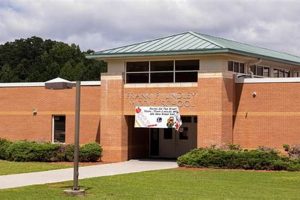Short, focused activities used at the start of class to quickly engage students and transition them into the day’s learning are a common practice in middle school classrooms. These exercises can take various forms, including quick writing prompts, problem-solving tasks, or reviews of previously learned material. For example, a math teacher might present a brief word problem for students to solve individually or in pairs, while a history teacher might ask students to reflect on a historical event.
These introductory classroom activities offer several advantages. They can help recapture student attention after a break, activate prior knowledge relevant to the upcoming lesson, and establish a routine conducive to learning. Additionally, regular use of these activities can improve student engagement and foster a positive classroom environment. Historically, these practices have evolved from traditional oral recitation or dictation exercises to more interactive and varied learning experiences, reflecting changing pedagogical approaches.
The following sections will explore specific examples of effective opening activities across different subject areas, offering practical guidance for educators seeking to enhance student engagement and learning outcomes.
Tips for Effective Opening Activities
Careful planning and execution are essential for maximizing the effectiveness of introductory classroom activities. The following tips provide guidance for educators seeking to implement these practices successfully.
Tip 1: Keep it concise. Activities should be brief, typically lasting no more than 5-10 minutes, to avoid encroaching on valuable lesson time.
Tip 2: Align with learning objectives. Activities should directly connect to the day’s lesson or review previously covered material to reinforce learning and provide context.
Tip 3: Vary the format. Employing diverse activity types, such as puzzles, quizzes, discussions, or creative writing prompts, maintains student interest and caters to different learning styles.
Tip 4: Incorporate collaborative elements. Activities can encourage peer interaction and teamwork through pair or small-group work.
Tip 5: Provide clear instructions. Expectations should be clearly communicated to ensure student understanding and efficient use of time.
Tip 6: Offer regular feedback. Providing constructive feedback, even briefly, helps students gauge their understanding and reinforces learning.
Tip 7: Consider student interests. Incorporating topics relevant to student interests can enhance engagement and motivation.
By implementing these strategies, educators can leverage these brief activities to significantly enhance student engagement, knowledge retention, and overall classroom effectiveness.
In conclusion, strategically implemented opening activities offer valuable benefits for middle school classrooms.
1. Brief, Focused Activities
Brief, focused activities serve as a cornerstone of effective classroom management and student engagement, particularly in the middle school setting. These strategically implemented exercises, often referred to as “bell ringers,” offer a valuable tool for educators to maximize instructional time and create a conducive learning environment. Their brevity ensures minimal disruption to lesson plans while their focused nature targets specific learning objectives.
- Skill Reinforcement
Reviewing previously learned material through short, targeted activities strengthens student retention and provides opportunities for practice. A quick vocabulary review in a language arts class or a brief mental math exercise in mathematics serves as a practical example. This reinforcement helps solidify foundational knowledge and prepares students for more complex concepts.
- Engagement and Focus
Short, engaging activities capture student attention at the start of class, minimizing distractions and facilitating a smooth transition into the day’s lesson. A thought-provoking question related to current events in a social studies class or a quick logic puzzle in science can pique student curiosity and establish a focused mindset. This promotes active participation and reduces the likelihood of disruptive behavior.
- Curriculum Alignment
Connecting these brief activities directly to the day’s learning objectives ensures relevance and reinforces the importance of the material. A short writing prompt related to the main theme of a novel in English class or a quick review of key formulas before a physics lesson illustrates this connection. This approach enhances understanding and provides context for subsequent learning.
- Routine and Structure
Consistent implementation of brief, focused activities establishes a predictable classroom routine, promoting a sense of order and reducing anxiety. Students become accustomed to engaging in a specific task at the beginning of class, fostering a sense of stability and preparedness. This predictable structure contributes to a positive classroom environment conducive to learning.
The strategic use of brief, focused activities as “bell ringers” in middle school classrooms contributes significantly to effective instruction. By reinforcing skills, promoting engagement, aligning with the curriculum, and establishing a structured routine, these exercises optimize instructional time and create a learning environment that maximizes student success. Their consistent application cultivates a classroom culture characterized by focus, preparedness, and active participation.
2. Curriculum Alignment
Curriculum alignment serves as a critical foundation for effective bell ringer activities in middle school classrooms. A strong connection between these brief exercises and the overarching curriculum ensures relevance and maximizes learning outcomes. When bell ringers directly support and reinforce current learning objectives, they transition students smoothly into the day’s lesson, activate prior knowledge, and provide opportunities for focused practice. For instance, a bell ringer involving vocabulary review before a literature discussion reinforces language skills essential for textual analysis, while a brief review of historical timelines before a lecture on a specific era provides context and strengthens chronological understanding. Conversely, misaligned activities detract from valuable instructional time and may confuse students by introducing unrelated concepts. A clear connection between bell ringers and curriculum content fosters a sense of purpose, enhancing student engagement and demonstrating the practical application of acquired knowledge.
The practical significance of curriculum alignment in bell ringers extends beyond simply reinforcing specific concepts. It cultivates a cohesive learning experience where each activity contributes to a larger understanding. For example, a series of bell ringers focused on a particular mathematical concept over several days can build progressively, reinforcing foundational skills and preparing students for more complex problem-solving. This cumulative approach deepens understanding and promotes long-term retention. Furthermore, curriculum alignment ensures that bell ringers contribute meaningfully to assessment outcomes. By consistently reinforcing key skills and concepts, these activities prepare students for formal assessments, fostering confidence and reducing test anxiety.
In summary, curriculum alignment is essential for maximizing the effectiveness of bell ringers in middle school. This connection ensures that these brief activities serve a clear pedagogical purpose, reinforcing learning objectives, promoting engagement, and contributing meaningfully to student progress. Educators must prioritize this alignment to leverage the full potential of bell ringers as valuable instructional tools. Challenges may arise in finding creative and engaging activities that directly align with complex topics; however, the benefits of a well-aligned bell ringer strategy far outweigh the effort required for thoughtful planning and implementation. This practice ultimately contributes to a more coherent, engaging, and effective learning experience for middle school students.
3. Varied Formats
Employing varied formats in middle school bell ringer activities is crucial for maintaining student engagement and catering to diverse learning styles. A monotonous approach can lead to disinterest and reduced effectiveness. Strategic variation, however, transforms these brief exercises into dynamic learning opportunities that capture attention and reinforce learning objectives in stimulating ways. This exploration delves into the multifaceted benefits of incorporating diverse formats into bell ringer design.
- Interactive Quizzes
Utilizing interactive quizzes as bell ringers offers an engaging way to assess prior knowledge and stimulate recall. Platforms like Kahoot! or Quizizz provide interactive elements that enhance participation and provide immediate feedback. A quick quiz on previously covered grammar rules in English class or a review of scientific vocabulary in a science lesson exemplifies this approach. The gamified nature of these platforms motivates students and fosters a sense of friendly competition, enhancing knowledge retention and active participation.
- Creative Writing Prompts
Incorporating creative writing prompts encourages imaginative thinking and strengthens writing skills. A brief prompt related to a current social issue in social studies or a fictional scenario connected to a scientific concept in science class stimulates critical thinking and self-expression. This approach allows students to personalize their learning and explore different perspectives, fostering deeper engagement with the subject matter. Responses can be shared and discussed, further enriching the learning experience.
- Visual Puzzles and Challenges
Presenting visual puzzles or challenges, such as logic grids or optical illusions, as bell ringers promotes problem-solving skills and critical thinking. A visual puzzle related to geometric shapes in math class or a decoding challenge connected to historical codes in history class encourages analytical thinking and attention to detail. This format caters to visual learners and provides a stimulating mental exercise that enhances cognitive skills.
- Collaborative Discussions
Initiating brief, collaborative discussions as bell ringers fosters communication skills and encourages peer interaction. A discussion prompt related to a current event in social studies or a debate on ethical implications of scientific advancements in science class promotes critical thinking and active participation. This format allows students to share perspectives, build upon each other’s ideas, and develop communication skills in a structured setting. Facilitating these discussions effectively requires clear guidelines and moderation to ensure productive and respectful dialogue.
The strategic use of varied formats in bell ringer activities directly contributes to a more dynamic and engaging learning environment. By incorporating interactive quizzes, creative writing prompts, visual puzzles, and collaborative discussions, educators can cater to diverse learning preferences and maintain student interest. This approach transforms bell ringers from routine exercises into stimulating learning opportunities that enhance knowledge retention, critical thinking, and overall classroom engagement. The careful selection and implementation of diverse formats, aligned with curriculum objectives and student needs, maximizes the pedagogical value of bell ringers in middle school classrooms.
4. Promote Engagement
Promoting engagement represents a central objective of effective bell ringer implementation in middle school classrooms. These brief, introductory activities serve as a crucial tool for capturing student attention and fostering a focused learning environment at the start of class. The connection between bell ringers and student engagement hinges on their ability to activate prior knowledge, stimulate curiosity, and provide opportunities for active participation. For example, a thought-provoking question related to a current event in social studies can ignite discussion and critical thinking, while a brief, interactive quiz in science can review previously learned material in an engaging format. When designed strategically, bell ringers transform passive recipients of information into active learners, setting a positive tone for the entire lesson.
The impact of engaging bell ringers extends beyond simply capturing initial attention; they contribute significantly to overall learning outcomes. Activities that pique student interest and encourage active participation foster a deeper understanding of the subject matter. A hands-on activity in math, such as manipulating geometric shapes, can solidify abstract concepts, while a short writing prompt in English can encourage creative expression and critical analysis. Furthermore, engaging bell ringers can foster a sense of community and collaboration within the classroom. A collaborative brainstorming activity, for example, encourages peer interaction and the sharing of diverse perspectives. This sense of shared purpose further enhances student motivation and engagement.
In summary, the connection between bell ringers and student engagement is paramount for effective instruction in middle school. These activities, when thoughtfully designed and implemented, serve as a powerful tool for capturing attention, activating prior knowledge, and fostering a positive learning environment. Challenges may include accommodating diverse learning styles and managing time constraints; however, the benefits of increased engagement, improved learning outcomes, and a more dynamic classroom environment justify the effort invested in creating compelling bell ringer activities. Prioritizing engagement through these introductory exercises contributes significantly to a more enriching and effective learning experience for middle school students.
5. Skill Reinforcement
Skill reinforcement represents a fundamental benefit of incorporating bell ringers into middle school instructional practices. These brief, focused activities provide opportunities to revisit previously learned material, strengthening student retention and promoting automaticity. Consistent exposure to key concepts through bell ringers solidifies foundational knowledge and prepares students for more advanced learning. For example, regular review of mathematical operations through quick mental math problems at the start of class reinforces numeracy skills, while brief vocabulary reviews strengthen language proficiency. This consistent practice bridges the gap between initial learning and long-term retention.
The practical significance of skill reinforcement through bell ringers extends beyond simply refreshing memories. It cultivates a deeper understanding of core concepts by providing opportunities for repeated application in varied contexts. A recurring grammar exercise, for instance, can illustrate the nuances of sentence structure in different writing scenarios, while repeated exposure to scientific vocabulary in different contexts enhances comprehension and application. Furthermore, this reinforcement builds student confidence by providing opportunities for success in a low-stakes environment. Regular practice with foundational skills fosters a sense of mastery, encouraging active participation and reducing anxiety associated with more challenging tasks.
In summary, skill reinforcement through bell ringers serves as a cornerstone of effective instruction in middle school. These activities, when thoughtfully designed and aligned with curriculum objectives, transform routine review into engaging opportunities for sustained learning. Challenges may arise in balancing breadth of content with depth of reinforcement; however, the benefits of increased retention, deeper understanding, and enhanced student confidence justify the strategic incorporation of skill-focused bell ringers. This consistent practice cultivates a strong foundation for academic success by ensuring that foundational skills remain readily accessible and actively applied in the learning process.
6. Routine Establishment
Routine establishment represents a key benefit of consistent bell ringer implementation in middle school classrooms. Predictable structures, such as daily bell ringer activities, contribute significantly to a positive and productive learning environment. These routines provide a clear framework for classroom procedures, minimizing disruptions and maximizing instructional time. Students entering a classroom with an established bell ringer routine understand expectations, facilitating a smooth transition into learning and reducing anxiety associated with uncertainty. This predictable start to class allows teachers to address administrative tasks efficiently and prepare students for the day’s learning objectives. For example, a daily grammar exercise as a bell ringer not only reinforces language skills but also signals the beginning of focused learning, establishing a clear transition from hallway interactions to classroom engagement.
The impact of routine establishment through bell ringers extends beyond simple classroom management. Consistent routines foster a sense of order and stability, contributing to a positive classroom climate conducive to learning. When students feel secure in the predictability of classroom procedures, they can focus more readily on academic tasks and engage more effectively with the material. For instance, a daily review of key concepts through bell ringers not only reinforces learning but also provides a sense of continuity between lessons, fostering a cohesive learning experience. Moreover, established routines can empower students by providing a sense of control and ownership over their learning environment. A consistent opportunity to engage with material independently at the start of class, such as through a problem-solving bell ringer, can foster self-directed learning and build confidence. This sense of autonomy further contributes to positive engagement and academic progress.
In summary, routine establishment through bell ringers offers significant advantages in middle school classrooms. These routines streamline transitions, minimize disruptions, and foster a positive learning environment characterized by predictability and structure. While challenges may arise in maintaining routine flexibility and adapting to unforeseen circumstances, the benefits of increased instructional time, enhanced student engagement, and a more positive classroom climate justify the prioritization of routine establishment through consistent bell ringer implementation. This practice contributes significantly to a more structured, productive, and supportive learning experience for middle school students.
7. Transition Management
Transition management represents a crucial function of bell ringers in middle school classrooms. These brief, introductory activities serve as a bridge between disparate activities, smoothing transitions and maximizing instructional time. Effective transition management minimizes disruptions, reduces off-task behavior, and fosters a focused learning environment. Bell ringers provide a structured transition from hallway conversations or previous class activities to the current lesson’s objectives. For example, a brief review of the previous day’s material as a bell ringer can reactivate prior knowledge and seamlessly connect it to the current lesson’s focus. This structured shift in attention minimizes distractions and allows for immediate engagement with the learning task at hand. Without effective transition management, valuable instructional time can be lost to off-task behavior and disorientation, hindering learning progress and classroom efficiency. Bell ringers, therefore, serve as a valuable tool for optimizing instructional time and promoting a smooth flow between activities.
The practical significance of transition management through bell ringers extends beyond simply managing time. Well-structured transitions contribute to a positive classroom climate by reducing anxiety and promoting a sense of predictability. Students entering a classroom with an established bell ringer routine understand expectations, minimizing uncertainty and fostering a sense of order. A consistent transition activity, such as a daily vocabulary review or a short problem-solving task, signals the beginning of focused learning time, allowing students to mentally prepare for academic engagement. Furthermore, effective transition management through bell ringers can enhance student engagement by providing a clear focus and purpose for the upcoming lesson. A bell ringer that directly connects to the day’s learning objectives can pique student curiosity and activate prior knowledge, promoting active participation from the outset. This proactive approach to transition management fosters a learning environment characterized by focus, engagement, and efficient use of instructional time.
In conclusion, transition management facilitated by bell ringers plays a critical role in optimizing middle school classroom dynamics. These activities serve as valuable tools for minimizing disruptions, maximizing instructional time, and fostering a positive learning environment. While challenges may arise in designing engaging and relevant transition activities, the benefits of improved classroom management, increased student engagement, and a more productive learning experience justify the strategic implementation of bell ringers as transition management tools. This practice contributes significantly to a more structured, focused, and efficient learning environment, ultimately benefiting both teachers and students.
Frequently Asked Questions
This section addresses common inquiries regarding the implementation and effectiveness of short, introductory classroom activities in middle school settings.
Question 1: How much time should be allocated for these introductory activities?
Ideally, these activities should be concise, typically lasting no more than 5-10 minutes to avoid encroaching on valuable lesson time. Brevity ensures they serve as a focused warm-up rather than a separate activity.
Question 2: How can one ensure these activities align with curriculum objectives?
Alignment can be achieved by selecting activities directly related to the day’s lesson or reviewing previously covered material. This reinforces learning and provides context for new concepts. Consulting curriculum guides and planning activities in advance ensures relevance.
Question 3: What strategies can be used to maintain student interest and prevent these activities from becoming monotonous?
Varying the format is essential. Incorporating diverse activity types, such as puzzles, quizzes, discussions, or creative writing prompts, caters to different learning styles and prevents predictability.
Question 4: Are there specific benefits to incorporating collaborative elements into these activities?
Collaborative activities promote peer interaction and teamwork. Assigning pair or small-group work encourages communication, shared problem-solving, and a sense of community within the classroom.
Question 5: How can educators gauge the effectiveness of these activities and make adjustments as needed?
Regularly observing student engagement and collecting feedback offers valuable insights. Briefly reviewing responses and addressing common misconceptions reinforces learning and informs future activity selection.
Question 6: How can these activities be adapted for students with diverse learning needs?
Differentiation is key. Providing varied levels of challenge, offering alternative formats for responses, and incorporating visual aids or manipulatives ensures accessibility for all learners. Collaborating with special education staff can provide additional support and guidance.
Effective implementation of these strategies requires thoughtful planning and ongoing evaluation. Consistent use, coupled with attention to student feedback and curriculum alignment, maximizes the benefits of these introductory classroom activities.
The following section will offer specific examples of effective activities across various subject areas.
Bell Ringers for Middle School
Bell ringers for middle school represent a valuable pedagogical tool, impacting classroom dynamics, student engagement, and skill development. Careful consideration of curriculum alignment, varied formats, and routine establishment maximizes their effectiveness. These brief activities offer significant benefits for transition management, skill reinforcement, and fostering a positive learning environment. Strategic implementation requires ongoing evaluation and adaptation to meet diverse student needs and learning objectives.
Effective integration of bell ringers into middle school curricula contributes significantly to a more engaging and productive learning experience. Thoughtful planning and consistent implementation are essential for leveraging their full potential to enhance student learning outcomes and cultivate a positive classroom environment. Continued exploration of innovative approaches and best practices will further refine the utilization of bell ringers as valuable educational tools.







